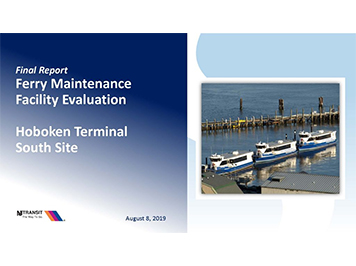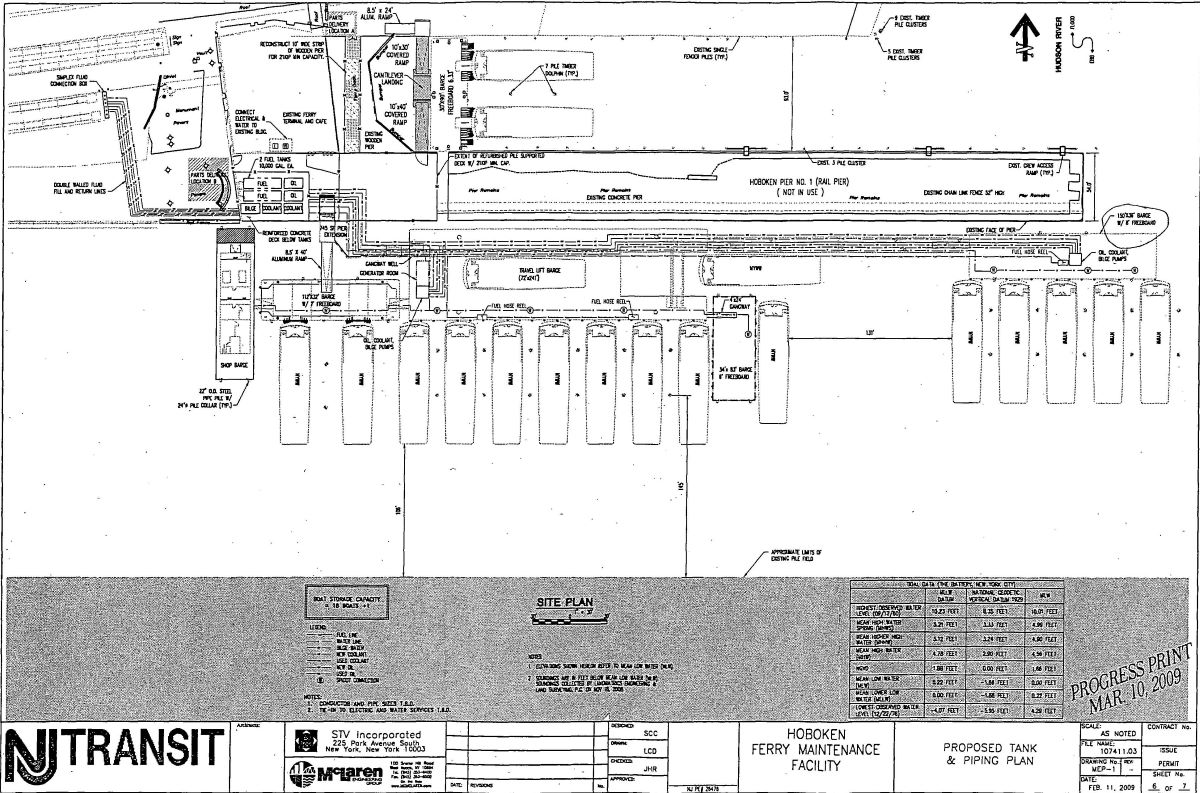Ron Hine | FBW | August 22, 2019
This week Governor Phil Murphy signed Executive Order 80 that requires NJ Transit to provide greater transparency and accountability to New Jersey commuters. On the issue of siting a ferry maintenance facility, however, NJ Transit has demonstrated a total lack of transparency and accountability to the Hoboken community and its elected officials.
Last week, NY Waterway released to the press NJ Transit’s Final Report – Ferry Maintenance Facility Evaluation – Hoboken Terminal South Site. This report omits critical facts and is devoid of any objective analysis. Instead, the report presents a one-sided view to favor NY Waterway’s contention that it must locate its ferry refueling/maintenance facility at Hoboken’s Union Dry Dock site.
NJ Transit, a public agency, kept local public officials in the dark as it drafted this report while receiving input on a regular basis from NY Waterway and its lobbyists. NJ Transit nowhere mentions the unique qualities of the Hoboken Cove where Union Dry Dock is located and its proximity to recreation, residential and educational uses. The report contains a series of other glaring omissions. Here are the facts:
FACT: The cost of NJ Transit acquiring Union Dry Dock currently stands at $13.1 million. There is no acquisition cost at the 80-acre Hoboken Terminal site that is wholly owned by NJ Transit.
FACT: In 2009, the NJDEP and the Army Corps of Engineers granted permits to NJ Transit for a ferry maintenance facility at the Hoboken Terminal. The 2009 permit approvals included detailed plans for how the facility would operate its refueling, berthing and repairs at the Hoboken Terminal.
FACT: Following Superstorm Sandy, NJ Transit received a $146 million grant from the Federal Transit Administration (FTA) to upgrade and repair the Hoboken Terminal. NJ Transit also received a $35 million FTA grant to repair the Depot Substation where NY Waterway formerly operated.
FACT: The $146 million grant includes filling the Long Slip Canal that will provide an additional roadway leading to the Hoboken Terminal South Site from Washington Boulevard in Jersey City. In addition, large capacity tankships deliver diesel fuel to vessels in the New York Harbor, thus eliminating the need for tanker truck deliveries at this site.
FACT: The report disregards the Union Dry Dock Company’s history of dredging. To operate in these shallow waters would require dredging, another multi-million dollar cost, that would be passed along to NJ Transit.
FACT: Over the past several years, NY Waterway repair trucks have used the “brick alley” roadway to access the Hoboken Terminal South Site for repairing its ferries.
The report falsely claims that refueling at the Hoboken Terminal poses a security threat. This ignores the fact that up until recently, NJ Transit has refueled its diesel locomotives at the Hoboken Train Terminal, some 40,000 gallons on a weekly basis. Last March, when the Hoboken Police Chief reached out to the Director of the NJ Office of Homeland Security, he was told there are no current threats for the Hoboken Terminal.
In fact, the NJ Transit report fails to mention or address the long list of concerns that have been raised by the public, elected officials, civic and environmental groups about locating a ferry maintenance/refueling facility at the Union Dry Dock site in the environmentally unique Hoboken Cove. For the past 30 years, at great expense, Hoboken has transformed its waterfront from a gritty industrial port to new residential, commercial and public open space development. Locating the refueling/maintenance facility at Union Dry Dock would create an incompatible, industrial use in the middle of a nearly completed contiguous waterfront park that is much beloved by the public.
In contrast to the highly questionable NJ Transit report of last week, in 2009, NJ Transit conducted a highly professional, exhaustive study entitled Ferry Berthing and Maintenance Facility — Alternate Site Analysis. This study took into account a number of objective factors to rank nine sites along New Jersey’s Hudson River coastline for a ferry home port. The criteria included regulatory permits/timing, vessel berthing capacity, upland pier capacity, landside access/utility availability, parking/transit access, impact to operations, dredging, capital costs, and land acquisition/ownership. Five sites were judged more suitable than the Union Dry Dock property. Similarly, the 2018 study completed by Boswell Engineering for the City of Hoboken also used objective criteria to evaluate alternate sites. Three sites were ranked as superior to Union Dry Dock.
In April of last year, after two aborted attempts by NJ Transit to put acquisition of Union Dry Dock on its Board of Directors agenda, Gov. Murphy promised Hoboken officials that the state would undertake a full alternate site analysis. The report prepared for NJ Transit by the NJDOT, WSP* and KPFF Consulting, however, only compared the Bayonne Peninsula (MOTBY) vs. Union Dry Dock. None of the numerous other options were included in their evaluation. They fail to acknowledge that the owner of NY Waterway still owns the 42 acres in Weehawken where the company currently refuels and repairs its ferry fleet. This presentation suffers from many of the same problems in the NJ Transit Report. Both reports were dated August 8, 2019.
*WSP recently purchased Parsons Brinckerhoff, the firm that Executive Director Corbett referenced.
On a personal note:
Last May, when NJ Transit’s Executive Director Kevin Corbett came to the Hoboken Terminal to speak with commuters, I had an opportunity to talk to him. I said that the Fund for a Better Waterfront has closely studied the issue of siting a ferry maintenance facility and would like to make a slide presentation to him of our findings. He declined, saying that he was dealing directly with the City of Hoboken. He also mentioned that the NJDOT had hired Parsons Brinckerhoff to do another study.
The next day, when I contacted the chief of staff for Hoboken’s mayor, he informed me that no one from NJ Transit had been in touch with the administration and despite numerous discussions with the Governor’s staff, no one had mentioned another study. Last week, city officials were blindsided when NY Waterway released the NJ Transit and NJDOT reports.
Related Stories
The site that no one knew about that could end NYWW-Hoboken fight Jersey Journal
Meet Phil Murphy’s inside man: The guy with access to the governor The Record 10-31-2018
Gov. Phil Murphy, Hoboken Mayor Ravi Bhalla at odds over Union Dry Dock vote – The Record 4-3-2018
Related Documents
NJ Transit option agreement with NY Waterway
Boswell Engineering Analysis of NJ Transit studies 8-20-19
NJT Ferry Maintenance Facility Evaluation: Hoboken Terminal South Site
NJDOT Ferry Maintenance Facility Study: MOTBY vs. Union Dry Dock
Environmental Groups Letter to Gov Murphy 8-8-2019
Port Imperial Marina Agreement (Weehaken)
Maraziti Falcon Letter to Governor’s Office March 8, 2019
Brendan Gill memo to Matt Platkin re: “eviction letter”
Romulus (Imperatore) ownership of Port Imperial Marina site block 45.01 lot 3.01
NJT 2009 Alternative Site Analysis
NJDEP 2009 permit to NJT showing detailed plans for facility at Hoboken Terminal
Boswell 2018 Alternative Site Analysis Report
Noelle Thurlow Biodiversity study at Hoboken waterfront
FBW submission to Army Corps 5-24-2018
Public Strategies Impact Lobbying Report First Quarter 2019
Public Strategies Impact Lobbying Report First Quarter 2018
Related Links
City to make offer to buy Union Dry Dock
City Council faced with standing room only crowd urging completion of waterfront park
15 environmental organizations urge Gov. to preserve Union Dry Dock as public space
3,000-year old outrigger canoe tradition lives on at the Hoboken Cove
NY Waterway’s improbable tale of eviction from Weehawken’s waterfront
Union Dry Dock is not an option for a ferry homeport but other sites are
FAQs on the ferry diesel depot proposed for Union Dry Dock site
NY Waterway lobbyists pressed Murphy administration to reverse course on Union Dry Dock
NY Waterway’s bogus talking points
The Life and Death of the Hoboken Cove
Hoboken mounts challenge to Army Corps/NJDEP permits
NJ Transit study identifies 5 sites more suitable than Union Dry Dock
FAQs: We answer your questions on NY Waterway depot in Hoboken
A brief history of NY Waterway and its founder, Arthur Imperatore
Tell NJ Transit Board to vote ‘no’ on MLK Day
Ferry homeport would reverse decades of progress at Hoboken waterfront
Public Park or Refueling Depot?
FBW letter opposing NJDEP permit application
NJ Transit’s dreadful plan for Hoboken waterfront
In 2012, NJ Transit abandons plans to acquire Union Dry Dock
FBW petition underscores Hoboken’s love of its waterfront
Union Dry Dock: Potential Parkland for Sale



